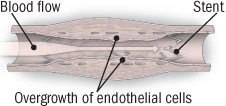Ask the doctor: How is a blocked stent fixed?
Ask the doctor
Q. What happens when a stent gets clogged up?
A. The procedure you are asking about is less common now because of improvements in stents.
Ever since the wire-mesh tubes known as stents were first used to prop open arteries after they were cleared of cholesterol-filled plaque, doctors have had to figure out how to open clogged stents. The most common method is to maneuver a drug-coated stent wrapped around a balloon into the middle of the closed-up stent. Inflating the balloon pushes aside the material obstructing the old stent and opens the new one. This often, but not always, solves the problem for good.
Reopening a blocked stent can often be done in a single procedure. Sometimes, though, it is necessary to use a tiny drill to cut through the obstruction, or a balloon to widen the opening before deploying a new stent.

Coronary arteries close up because they become narrowed by patches of cholesterol-laden plaque that bulge into the space available for blood flow. Stents close up for a different reason. After a stent is deployed, cells underneath it (endothelial cells) grow over and around the stent's metal struts, like skin over a wound. That helps the stent look like part of the body. With the original bare-metal stents, about one-third of the time endothelial cells continued growing into the open area inside the stent. This unrestrained growth, called restenosis, can block blood flow to the heart muscle.
Today, most stents are coated with drugs that inhibit the overgrowth of endothelial cells. Although drug-coated stents are much less likely to close up than bare-metal stents, the price of this benefit is taking anti-clotting medications for a year or more and then aspirin indefinitely to prevent the rare but potentially deadly formation of a blood clot on the stent.
—Thomas Lee, M.D., Former Editor in Chief, Harvard Heart Letter
Disclaimer:
As a service to our readers, Harvard Health Publishing provides access to our library of archived content. Please note the date of last review or update on all articles.
No content on this site, regardless of date, should ever be used as a substitute for direct medical advice from your doctor or other qualified clinician.












